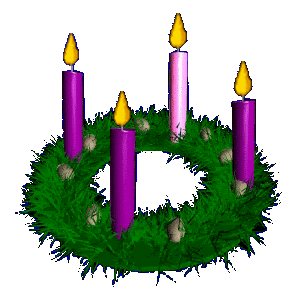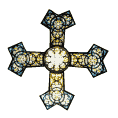Hospital Sojourn.
In course of discharge from the Royal Infirmary Infirmary, I went down to shopping for the Nurses.
Above the Central Desk I saw a large painting apt for the Christmas season by Agamemnon 2006.
The man at the telephones gave me the nuggets of information, the name of the artist, and the fact that he made the painting in acknowledgment for his healing from cancel.
 |
| Circle of LifeTriptych Royak Infirmary Edinburgh 2006 |
· About Me
· Art in Healing Spaces
· “I believe both patient and caregiver thrive in a healing environment. An integral part of healing is caring and comfort. Art is a bridge between those two factors. Inspiring, emotive art helps create a space where a hospital becomes hospitable” AO
 |
| Agamamnon Otero |
August 2003, Aberdeen Royal Infirmary
Ongoing project
Many studies conclude that art in healing spaces is integral to a successful environment to heal and be healed in. (See below) Working on projects or exhibitions within hospitals and healing spaces is something I’m always interested in considering. (click here to contact me re working on such a project) Over the past twelve years I’ve held exhibitions in hospitals in America and in the United Kingdom - including the Columbia Presbyterian Cancer clinic in New Milford, Connecticut, The Chelsea and Westminster Hospital - entrance hall gallery, London and in The Pelican Gallery at the Royal Infirmary of Edinburgh.
In October 2003, I successfully completed treatment for an advanced cancer. After receiving four months of intensive chemotherapy, and spending a substantial amount of time in hospital beds or visiting outpatients clinics, I was inspired to paint, for healing spaces, supportive imagery, either on canvas or as murals. They would be bold in colour, warm in content, soothing, viewing for all ages.
While studying at university in America, I worked part-time as a medical assistant for two years. I understand therefore, what it is to work within a medical facility. This, alongside my own experiences with serious illness, aged 18 with a life threatening benign tumour, and again aged 26 with an unrelated cancer, has given me insight into both sides of the hospital environment. I believe this provides me with a particular sensitivity towards the needs of all those within a healing space, carers and patients alike.
My abilities as an artist, my own experiences with long hospital stays, coupled with B.A in pre-medicine, M.Sc. Architecture:AEES, and having worked as a doctors assistant, uniquely qualify me for producing artworks and working in an creative and inspiring capacity in healing environments.
Panellist - Patient Environments & the Arts January 22nd, 2007
In January 2007, I was invited to join the discussion panel at the "Patient Environments & the Arts" conference at the Royal College of Physicians, Regents Park, London. Organised by Wilmington Conferences, we debated the findings of two independent 'Patient & Environment' Department of Health evaluations and how to put them into practice. Like many studies before, these evaluations concluded that art should be an integral part of the healing process and environment. The main issue of the day kept returning to funding and the lack of it.
Please click on the underlined heading 'Panellist - Patient Environments & the Arts' above to read an independent article which summarises the day. The very last paragraph mentions some of my input.
My 'Mother & Son' series is on a 5 year loan with the Royal Infirmary of Edinburgh until November 2009. They hang in main atrium's reception hall.
Please click on 'Art Loans' underlined above to view the Mother & Sons series.
The NHS Lothian newspaper 'CONNECTIONS' reported in January 2005:
"A artist who had cancer has loaned some of his most powerful work to the Royal Infirmary of Edinburgh as a thank you to Scottish doctors who helped to save his life. Uruguayan-born Agamemnon Otero (28) beat a life threatening tumour at the age of 18, only to be struck down with cancer eight years later. However with the help of experts in Scotland and intensive chemotherapy he was given the all clear. He chose four of the most evocative paintings from his colourful Mother & Son series, featuring the close relationship between parent and child, to hang on the walls of RIE for the next five years. These four works can be enjoyed today in the Mall of the Royal Infirmary, immediately next to the reception desk. Agamemnon said: “Having been successfully treated by the NHS in Scotland last year, I wished to give something positive back to all the people within a Scottish hospital.” He says that his own experiences of illness have given him a unique insight into the needs of healing institutions and their patients. “I believe both patients and caregivers thrive in a healing environment. An integral part of healing is caring and comfort. “Art is a bridge between those two factors. Inspiring, emotive art helps create a space where a hospital becomes hospitable.” Agamemnon is also gifting a special painting to the hospital, which will further illuminate the theme of relationships between people. Dr Ian Laing, arts committee chairman at RIE, said: “It is a real privilege to have someone of Aga’s talent giving so generously to us here in Edinburgh and we are thrilled to have his wonderful work on our walls.”
Edinburgh Royal Infirmary - Public Collection
By way of saying thank you to the Scottish NHS for saving my life, I have donated a specially commissioned painting, the 'Circle of Life' a triptych measuring 2.5m x 3m, to the Royal Infirmary of Edinburgh. It was unveiled on the 29th November 2006 in the hospitals' main receptions atrium and is hung opposite my Mother & Son series. Two years prior, during the installation of the Mother & Sons series, I came upon an idea that the wall opposite called for a large work to compliment the light airy space of the reception area. Discussing this with Dr Ian Laing, the then head of the hospital arts committee, we both agreed on the importance of feeling supported at times of ill health, whether as a patient or as a career, and thus, the original concept of the ‘Circle of Life’ was born.
The ‘Circle of Life’, is a huge triptych measuring nearly 2.5 meters high by over 3 meters wide. It seeks to represent the amalgamation of today’s society by illustrating the cross-cultural, inter-generational & multi-denominational visitors of a modern day hospital. In sickness, as with health, there are no class boundaries, no age restrictions, no ‘illness free post codes’. Everybody struck by ill health, whether personally or by proxy because a loved one is suffering, is vulnerable, and equally all are in need of support. The ‘Circle of Life’ depicts a global family of comfort. It places the importance of family central to the caring network that surrounds us. Even if that ‘family’ may not nowadays be blood related. The painting sets about to remind us we are not alone, someone is out there who can relate to and support us in times of need.
Set in the colours of summer, the triptych shows great grandparents and all the generations’ in-between, to soon to be parents all dancing in the circle of life. The boundaries normally drawn by ethnicity's, faith and ages are removed, to reveal a harmony of humanity supporting and encouraging life and it’s spiral. The Circle of Life aims to provide an image of unity, which invokes health. Each bond formed allows the viewers to enter the picture from grandmother and mother to uncle and aunts. A multicoloured support group that through its web allows none to fall through.
Please click on 'The Circle of Life' headline, underlined above, to view the triptych.














